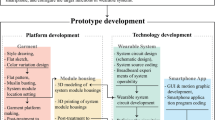Abstract
The purpose of this study is to inform the development of visibility-enhanced bicycling safety clothing using flashing LEDs on bio-motion joints, and to evaluate the effects of this active visibility technology on bicyclist visibility under both daytime and night-time conditions. To evaluate the effectiveness of LED visibility aids, a survey and video evaluation of visibility was conducted online with 133 participants, who both drive a car and ride a bicycle. Video recordings of bicycle trials were made under four viewing conditions: with the flashing LEDs on during daytime and night-time, and with the flashing LEDs off during daytime and night-time. Data were analyzed with ANOVA and Duncan Test, and the results show that the bicycling smart wear improved the perceived visibility of the bicyclist at night, and helped the bicyclist to be more recognizable and detectable under night-time conditions (p < 0.001). With respect to observer perception regarding safety and accidents, wearing the developed bicycling smart wear during times of poor visibility increased perception that bicycling is safer (p < 0.001). The results revealed the LED technology improved perceived visibility of the bicyclist, observer’s recognition and detection of the bicyclist.
Access this chapter
Tax calculation will be finalised at checkout
Purchases are for personal use only
Similar content being viewed by others
References
European Road Safety Observatory (2008) Pedestrians and cyclists. ERSO. http://www.erso.edu. Accessed 16 Jan 2011
Kwan L, Mapstone J (2004) Visibility aids for pedestrians and cyclists: a systematic review of randomised controlled trials. Accid Anal Prev 36:305–312
Rumar K (1990) The basic driver error: late detection. Ergonomics 32(10–11):1281–1290
Bloomberg D, Hale A, Preusser F (1986) Experimental evaluation of alternative conspicuity-enhancement techniques for pedestrians and bicyclists. J Saf Res 17(1):1–12
McGuire L, Smith N (2000) Cycling safety: injury prevention in Oxford cyclists. Inj Prev 6:285–287
National Highway Traffic Safety Administration (2007) Traffic safety facts: 2007 data: bicyclists and other cyclists. National Center for Statistics and Analysis. http://www-nrd.nhtsa.dot.gov/pubs/810986.pdf. Accessed 17 Jan 2011
Balk SA, Carpenter TL, Brooks JO et al. (2006) Pedestrian conspicuity at night: how much biological motion is enough? In: 2006 annual meeting of the transportation research board. http://www.thecochranelibrary.com/userfiles/ccoch/file/Safety_on_the_road/CD003438.pdf. Accessed 17 Jan 2011
Luoma J, Penttinen M (1998) Effects of experience with retroreflectors on recognition of night-time pedestrians: comparison of driver performance in Finland and Michigan. Transp Res 1(1):47–58
Luoma J, Schumann J, Traube E (1996) Effects of retroreflector positioning on nighttime recognition of pedestrians. Accid Anal Prev 28(3):377–383
Owens A, Antonoff J (1994) Biological motion and pedestrian safety in night traffic. Hum Factors: J Hum Factors Ergon Soc 36(4):718–732
Tyrrell A, Wood M, Chaparro A, Carberry P (2009) Seeing pedestrians at night: visual clutter does not mask biological motion. Accid Anal Prev 41:506–512
Wood M (2005) Limitations in drivers’ ability to recognize pedestrians at night. Hum Factors: J Hum Factors Ergon Soc 47(3):644–653
Kittur A, Chi H, Suh B (2008) Crowdsourcing user studies with mechanical turk. In: Proceedings CHI’08, Florence, Italy, pp 453–456. doi.10.1145/1357054.1357127, 5–10 April 2008
Author information
Authors and Affiliations
Corresponding author
Editor information
Editors and Affiliations
Rights and permissions
Copyright information
© 2012 Springer-Verlag London
About this paper
Cite this paper
Koo, H., Dunne, L. (2012). Enhancing Visibility in Bicycling Apparel Using Integrated Flashing LEDs. In: Breedon, P. (eds) Smart Design. Springer, London. https://doi.org/10.1007/978-1-4471-2975-2_5
Download citation
DOI: https://doi.org/10.1007/978-1-4471-2975-2_5
Published:
Publisher Name: Springer, London
Print ISBN: 978-1-4471-2974-5
Online ISBN: 978-1-4471-2975-2
eBook Packages: EngineeringEngineering (R0)




